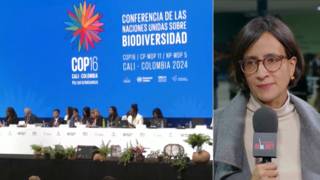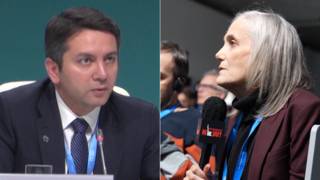
Related
Guests
- Mark SchapiroEditorial director of the Center for Investigative Reporting in San Francisco.
With the Copenhagen climate summit just a month away, a new investigative series looks at how rural Brazilians are being displaced so their forest can be turned into carbon offsets for some of the world’s biggest polluters, including General Motors and Chevron. With deforestation amounting to a fifth of the world’s emissions, planting and preserving trees are seen as key elements to offset pollution. We speak to Mark Schapiro of the Center for Investigative Reporting. After traveling to Brazil, Schapiro writes, “People with some of the smallest carbon footprints on earth are being displaced by companies with some of the biggest.” [includes rush transcript]
Transcript
AMY GOODMAN: As we continue with our climate countdown to Copenhagen — yes, the Copenhagen climate summit just a month away — we look at the lucrative business that global warming has generated. The buying and selling of carbon credits earned from reducing greenhouse emissions is already a $150 billion market. Negotiations in Copenhagen are expected to focus at least in part on how to regulate this fast-growing carbon market.
Central to the debate is how to deal with the world’s forests. Trees are a key commodity in this business, because they soak up carbon dioxide in the atmosphere. With deforestation amounting to a fifth of the world’s emissions, planting and preserving trees are seen as key elements to offset pollution.
Well, as part of a collaborative investigation by the Center for Investigative Reporting and FRONTLINE/World, Mark Schapiro from the Center for Investigative Reporting traveled to Brazil’s Atlantic coast. He visited a forest that could soon become part of the global carbon economy.
In this video clip, available at FRONTLINE/World’s Carbon Watch website, Brazilian forestry expert Ricardo de Britez tells Mark Schapiro how to measure the amount of carbon sequestered in a tree.
RICARDO DE BRITEZ: [translated] To measure the carbon in a tree, I need to measure the weight of the tree. By measuring the diameter, I can enter it into an equation that will give me the weight.
MARK SCHAPIRO: How much carbon would you think is in this tree?
RICARDO DE BRITEZ: [translated] I think it probably contains between ninety-five to a hundred kilos of carbon.
MARK SCHAPIRO: Basically, there are a thousand kilograms in a ton. If you have ten of these trees, you’ve got a ton of carbon. And if carbon is basically selling on the market — what does it cost now? About $10 —-
RICARDO DE BRITEZ: Yeah.
MARK SCHAPIRO: —- a ton?
RICARDO DE BRITEZ: Yes, uh-huh.
MARK SCHAPIRO: So, basically, ten of these, you’ve made $10. This tree is basically worth —-
RICARDO DE BRITEZ: One dollar.
MARK SCHAPIRO: One dollar.
RICARDO DE BRITEZ: Yeah, one dollar.
MARK SCHAPIRO: Yeah, one dollar in the carbon market.
RICARDO DE BRITEZ: Yes.
MARK SCHAPIRO: Yeah. So tell me, then. The particular carbon in this tree belongs to which company?
RICARDO DE BRITEZ: [translated] The credits from that carbon belong to General Motors.
MARK SCHAPIRO: Uh-huh. So this is the reserve -—
RICARDO DE BRITEZ: Yeah.
MARK SCHAPIRO: — that General Motors supports.
RICARDO DE BRITEZ: [translated] That’s correct.
AMY GOODMAN: That’s right. General Motors, along with Chevron and American Electric Power — three of the planet’s leading polluters — teamed up with the US-based Nature Conservancy to purchase 50,000 acres of Brazilian forest land. The reserves are managed by the Brazilian conservation group SPVS, the Society for Wildlife Research and Environmental Education.
Nature Conservancy cites the project as, quote, “an invaluable contribution to the preservation of the planet’s biodiversity.” In addition, of course, the corporations get the potentially lucrative rights to the carbon sequestered in these trees.
But what happens to the local communities living in and around the forest? In an article called “GM’s Money Trees” published in the latest Mother Jones magazine, Mark Schapiro writes, quote, “People with some of the smallest carbon footprints on earth are being displaced by companies with some of the biggest.”
Mark Schapiro is the editorial director for the Center for Investigative Reporting, joining us now from the University of California, Berkeley.
Mark, welcome to Democracy Now! Continue with this story, how you discovered it and what you found in Brazil.
MARK SCHAPIRO: What I found in Brazil, I came upon it through beginning some research on the carbon market, which I’m doing now for the Center for Investigative Reporting. And what I discovered was that there was this reserve being set up.
And right now there’s a huge debate going on in the United States in Washington this very minute. They’re debating the question of the role that forests are going to play in the new emission control system here in the United States. The argument in America is essentially that we — that companies could use forest lands, which means essentially buying a forest and agreeing not to cut it down, which would qualify to offset the emissions of companies producing emissions in the United States. Much of the rest of the world disagrees with this approach, and so I think it’s actually going to be one of the big disputes in Copenhagen, as the negotiations move forward.
So I found this particular example, which I found a kind of a fascinating way to explore the implications of this issue, a deal in which, as you said, three companies — General Motors, Chevron and American Electric Power — went into an arrangement with the Nature Conservancy and basically engaged in an act — a transaction that I think is brand new to this world of global warming economics. And what is that transaction? Essentially, the companies provided a donation to the Nature Conservancy, which, of course, makes an effort to preserve lands in different parts of the world and in our own country, and that — the Nature Conservancy then turn it over to a group in Brazil, which then sort of administers its reserve.
Here’s the interesting thing about that: the companies don’t end up owning the land, nor do they end up owning the trees, but they actually end up having the rights to trade the carbon that’s sequestered in those trees. And I thought this was a very interesting way to explore the implications of this — of what we could be facing once we get America’s own emission limits established, when there could be millions of acres worth of forest established with similar kind of provisions.
AMY GOODMAN: Mark Schapiro, I want to play another excerpt from the video up on the Carbon Watch website at FRONTLINE/World. This one features a farmer living near the General Motors reserve.
BRAZILIAN FARMER: [translated] We’re workers who live from the forest. We’ve always taken care of the earth, of the richness of our biodiversity. Human beings are part of the ecosystem. All the richness that you see was preserved because people have been here.
MARK SCHAPIRO: This principle of coexisting with the forest has clashed with the principle of preserving it. Literally.
BRAZILIAN FARMER: [translated] SPVS doesn’t want us here. They don’t want human beings in the forest. The land isn’t even theirs; it’s ours.
AMY GOODMAN: Mark Schapiro, give us the context.
MARK SCHAPIRO: Well, this is kind of an extraordinary moment. We went deep into the reserve. This is incredibly beautiful, primitive, pristine forest. It takes hours to get anywhere, either by muddy roads or else by canoe. And in this case we traveled by canoe deep into the — deep into the reserve. And we encountered several people, including this gentleman who, numerous times, engaged with the Green Police. They had established a Green Police force in this area, which patrols the outlines of the reserve. Now, what you have is you have dozens and dozens of villages on the outline edges of the reserve. Several thousand people live around this reserve, and they live in little subsistence villages, small villages, barely — you could barely call them villages. I mean, they’re settlements, little small huts and such. And people have actually lived off the forest for generations, hunting, fishing, gathering the fruits from the forest.
And suddenly, after this reserve was established, they have found that the perimeter of the reserve was being patrolled, and they were no longer able to get access to the reserve to gain access to the fruits of the forest. And so, what you’ve had is numerous clashes between residents of these areas, of these very, very remote areas, and this troupe of police, an arm of the state police now called the Green Police, which prohibits people from cutting down the trees that they use to build their homes or hunting the animals that they use to eat.
And this was very, very — quite something to actually see, because the fact is that the biodiversity in this area is critical to the future of the planet, and the ability to keep these trees standing is actually critical to our future, as we move forward in trying to slow the rate of climate change. So the idea of preserving these trees is completely critical to the planet’s future. The question is, how do you do it? And the fact is that there have been black market — black market operations in some of these areas, obtaining precious palmito, hearts of palm, and wild birds and such like that. But what we found repeatedly throughout this area was that the main enforcement was being directed at people who live there, as opposed to these kind of black market operations.
And so, I think as — my point in — one of my points, certainly, in doing this series of stories was to explore some of the challenges that we face as the United States, in particular, moves forward on the debate involving forests as emission offsets. There’s absolutely no question that forests need to be — remain standing and that forests can play a very critical role in reducing levels of greenhouse gas emissions.
AMY GOODMAN: Mark Schapiro, you mentioned the Green Police, and I wanted to turn to one of the video clips on the Green Police and how they harass local communities living near the GM, the General Motors, forest.
MARK SCHAPIRO: We went on patrol with a Força Verde crew, taking off across the Bay of Paranaguá. Though the term “Green Police” may sound benign to us, it was clear that the locals feared them. They have the power to fine, confiscate and even arrest fishermen, hunters and others who violate the rules.
Lieutenant Albano told us that enforcement has intensified since the carbon sequestration efforts began. They carry the guns. SPVS provides the intelligence. And ultimately, the US corporations provide the funds.
AMY GOODMAN: Mark Schapiro, take it from there. The US corporations provide the funds for the so-called Green Police. Explain.
MARK SCHAPIRO: This is a trail that — the US companies provide the money to — for the purchase of this land. And in order to obtain a level of certainty, there’s a requirement. If you’re going to establish a carbon credit reserve, which is really what’s happening here, that demands several things. And that includes a level of predictability in the measurements. I mean, one of the controversies now is really how predictable forests can be — how predictably they can be measured. But one thing it demands is a predictability in the measurements, so you can establish how much volume. You saw the man measuring the tree. And what you do to establish the quantity of carbon in that reserve is you extrapolate from that single tree to the hundreds of thousands of trees throughout the reserve, and you figure out how much carbon is contained in those trees. So, to establish a predictable measurement, you have to really limit the disruptions within the forest. And so, the Green Police, which is an established state police force —-
AMY GOODMAN: We have fifteen seconds, Mark.
MARK SCHAPIRO: —- now is charged with enforcing the reserves. The money from the companies goes to the Nature Conservancy, which in turn gives it to the Brazilian conservation organization, which in turn cooperates very closely with the Green Police and does a lot of training. So the links —
AMY GOODMAN: Ten seconds.
MARK SCHAPIRO: Mm-hmm. And so, this is how the connection works. And the point was to draw the links between the United States and an offset in a very remote part of the world.
AMY GOODMAN: Mark Schapiro, you did a remarkable job, from the Center for Investigative Reporting, speaking to us from the University of California, Berkeley. We will link to your website for all of the video clips and the investigative work you have done, also wrote for Mother Jones magazine.












Media Options